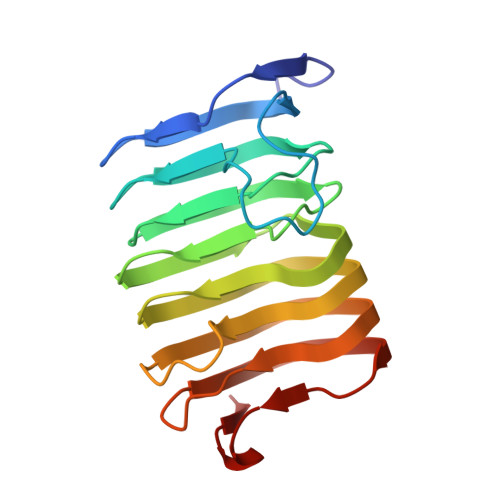The structure and mode of action of Caldicellulosiruptor bescii family 3 pectate lyase in biomass deconstruction.
Alahuhta, M., Brunecky, R., Chandrayan, P., Kataeva, I., Adams, M.W., Himmel, M.E., Lunin, V.V.(2013) Acta Crystallogr D Biol Crystallogr 69: 534-539
- PubMed: 23519661
- DOI: https://doi.org/10.1107/S0907444912050512
- Primary Citation of Related Structures:
4EW9 - PubMed Abstract:
The unique active site of the Caldicellulosiruptor bescii family 3 pectate lyase catalytic module (PL3-cat) has been structurally described and synergistic digestion studies with C. bescii cellulase A have been performed on unpretreated biomass. The X-ray structure of PL3-cat was determined at 1.6 Å resolution (PDB entry 4ew9) in complex with the products of trigalacturonic acid. Comparison with family 1 pectate lyase (PL1) structures shows that the active site of the PL3 catalytic module is considerably different. However, on superimposing the identical sugar rings at the -2 subsites conserved interactions could be identified. Interestingly, only one catalytic residue, the lysine that donates the proton to the carboxylate group in the β-elimination reaction of PL1 (Lys108 in PL3-cat), is conserved in PL3 and there is no arginine to abstract the proton from the C5 carbon of the galactouronate ring. This suggests that the reaction mechanism of PL3 requires different catalytic residues. Most interestingly, comparison with other proton-abstraction reactions reveals that in PL3 the α-proton is abstracted by a lysine, in a striking similarity to enolases. These observations led us to propose that in PL3-cat Lys108 is the catalytic base, Glu84 is the catalytic acid and an acidified water molecule completes the anti β-elimination reaction by protonating the O4 atom of the substrate. Also, our digestion experiments with unpretreated switchgrass show that the loadings of C. bescii cellobiohydrolase A (CelA) can be lowered by the addition of PL3 to the reaction mixture. This result suggests that PL3 can significantly improve the deconstruction of unpretreated biomass by allowing other enzymes to better access their preferred substrates.
Organizational Affiliation:
Biosciences Center, National Renewable Energy Laboratory, Golden, CO 80401-3305, USA.




















